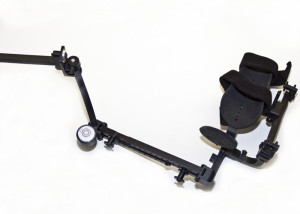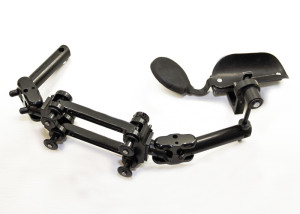
Mobile Arm Devices
The Mobile Arm Support was first conceived in the 1950s at Ranch Los Amigos Hospital in California, and was the brainchild of a patient who was there for rehabilitation due to polio. His idea was to eliminate the effects of gravity on the arm, which should theoretically make it easier to use. If successful, he reasoned, some of the people with spinal cord injuries he met while in the hospital might be able to use their arms again. Working with the folks at Rancho Los Amigos they came up with a design which placed a series of rubber bands parallel to the upper arm which effectively “floated” the arm. It worked, and the original mobile arm support was born. It was bulky, somewhat cumbersome, and offered limited adjustability… But the idea was sound. The polio patient went on to become an orthotist prosthetist, and started his own company manufacturing these supports in 1955.
Years later the son of the inventor, himself an orthotist prosthetist, again worked with Rancho Los Amigos to redesign his parents’ original work making the device less bulky. They also redesigned the mounting hardware allowing for increased adjustability and greater ease of adjustment, and introduced the Multilink and Elevating Multilink mobile arm supports in the late 1990s.
In 2004 the researchers at Dupont Childrens Hospital in Wilmington, Delaware took the Multilink designs a step further, and created the Wilmington Robotic Exoskeleton (WREX). Unlike the Multilink the WREX is an anatomically designed mobile arm device which closely mimics the user’s arm, allowing for increased function and a more “intuitive” feel. Many users comment that with the WREX it feels like they are in control and that they are moving the arm vs. the more mechanical feel of the Multilink.
Both devices have their pros and cons. The WREX allows for greater range of motion and provides a more intuitive feel than the Multilink, but because of its anatomical design requires more precision in its setup and use. If the user changes position in his chair, the WREX becomes less effective due to the change in its orientation with the user’s arm. Should the same occur while using the Multilink, however, the Multilink would better maintain its effectiveness.
Through our evaluation process we determine the best product for each individual user.
WREX
 WREX is a modular body-powered orthosis that is mounted to a person’s wheelchair or other seating systems. It is a two-segment, four-degrees-of-freedom exoskeletal arm, energized by elastic bands that aid in moving the arm in 3D space.
WREX is a modular body-powered orthosis that is mounted to a person’s wheelchair or other seating systems. It is a two-segment, four-degrees-of-freedom exoskeletal arm, energized by elastic bands that aid in moving the arm in 3D space.  The WREX allows full passive range of motion of the arm and provides a sense of flotation that assists in voluntary movement. It can easily be adjusted to accommodate subjects of different size, weight, and arm lengths by changing the number of bands or sliding the telescoping links. The WREX is assembled as left or right, and comes in two sizes to fit children through adult arms.
The WREX allows full passive range of motion of the arm and provides a sense of flotation that assists in voluntary movement. It can easily be adjusted to accommodate subjects of different size, weight, and arm lengths by changing the number of bands or sliding the telescoping links. The WREX is assembled as left or right, and comes in two sizes to fit children through adult arms.
Multi-link

The Multi-Link allows significantly greater range of motion for eating, drinking and facial hygiene.  This design has more lifting power with fewer rubber bands. Two sizes cover children through adult, and can be assembled for left or right arm.
This design has more lifting power with fewer rubber bands. Two sizes cover children through adult, and can be assembled for left or right arm.
 WREX is a modular body-powered orthosis that is mounted to a person’s wheelchair or other seating systems. It is a two-segment, four-degrees-of-freedom exoskeletal arm, energized by elastic bands that aid in moving the arm in 3D space.
WREX is a modular body-powered orthosis that is mounted to a person’s wheelchair or other seating systems. It is a two-segment, four-degrees-of-freedom exoskeletal arm, energized by elastic bands that aid in moving the arm in 3D space.  The WREX allows full passive range of motion of the arm and provides a sense of flotation that assists in voluntary movement. It can easily be adjusted to accommodate subjects of different size, weight, and arm lengths by changing the number of bands or sliding the telescoping links. The WREX is assembled as left or right, and comes in two sizes to fit children through adult arms.
The WREX allows full passive range of motion of the arm and provides a sense of flotation that assists in voluntary movement. It can easily be adjusted to accommodate subjects of different size, weight, and arm lengths by changing the number of bands or sliding the telescoping links. The WREX is assembled as left or right, and comes in two sizes to fit children through adult arms.

